Mon - Fr 9:00 am - 5:30 pm
3760 Oceanic Way STE 501, Oceanside, CA 92056
Posted by Gen819 Comments Off on Protecting Your Roof: Essential Maintenance for Longevity Residential Roofing
Protecting Your Roof: Essential Maintenance for Longevity
Every home has a silent guardian above it—your roof—working day and night to shield you from pounding rain, blazing sun, and biting winds. But when was the last time you gave it the care it needs to keep protecting you? Like any protective gear, it needs regular check-ups to keep doing its job. According to the National Roofing Contractors Association, a neglected roof can turn a $300 fix into a $3,000 repair, and skipping inspections can shorten its lifespan by years.
A proactive approach to roof upkeep prevents leaks, structural damage, and mold growth before they escalate into costly emergencies. Seasonal care is especially important—spring storms and winter freezes can cause hidden damage that, left unaddressed, will only worsen. Advances in roofing technology, from solar shingles to smart leak sensors, now offer homeowners new ways to protect and even improve their roofs’ performance.
Regular maintenance not only safeguards your home’s structural integrity but also boosts energy efficiency, curb appeal, and resale value. In this guide, you’ll learn a year-round maintenance checklist and discover emerging tools and materials that can extend your roof’s life well beyond the industry average—saving you money and giving you peace of mind in every season.
1. Regular Inspection and Why It Matters
Your roof faces daily battles against sun, wind, rain, and seasonal extremes—and even small, hidden weaknesses can grow into expensive headaches if left unchecked. That’s why experts, including the National Roofing Contractors Association, recommend inspecting your roof at least twice a year—once in the spring after winter’s stress, and again in the fall before harsh weather sets in—plus after any severe storm. These inspections can add years to your roof’s lifespan and save thousands in repair costs.
Begin from the ground with a binocular check for missing, curled, cracked, or discolored shingles. Watch for excessive granule loss—often seen as dark, sand-like particles in gutters or around downspouts—which signals shingle wear. Take note of any visible sagging, a red flag for possible structural compromise.
If it’s safe, inspect up close, paying special attention to flashing around chimneys, skylights, and vents. Look for rust, cracks, or gaps where water could enter. Scan for moisture indicators like moss, algae, or mold growth—signs of trapped water that can accelerate decay.
Don’t forget the inside check: in your attic and along ceilings, look for water stains, dampness, or mold. Even small leaks can undermine insulation and, over time, weaken your home’s structure.
Pro Tip: Use a seasonal photo log—snap pictures during each inspection and compare over time to spot subtle changes you might otherwise miss.
Regular inspections are more than preventive maintenance—they’re a long-term investment in your home’s safety, efficiency, and resale value. And if climbing ladders isn’t your thing, a professional roofer can provide a detailed, safe, and thorough assessment—often spotting issues invisible to the untrained eye.
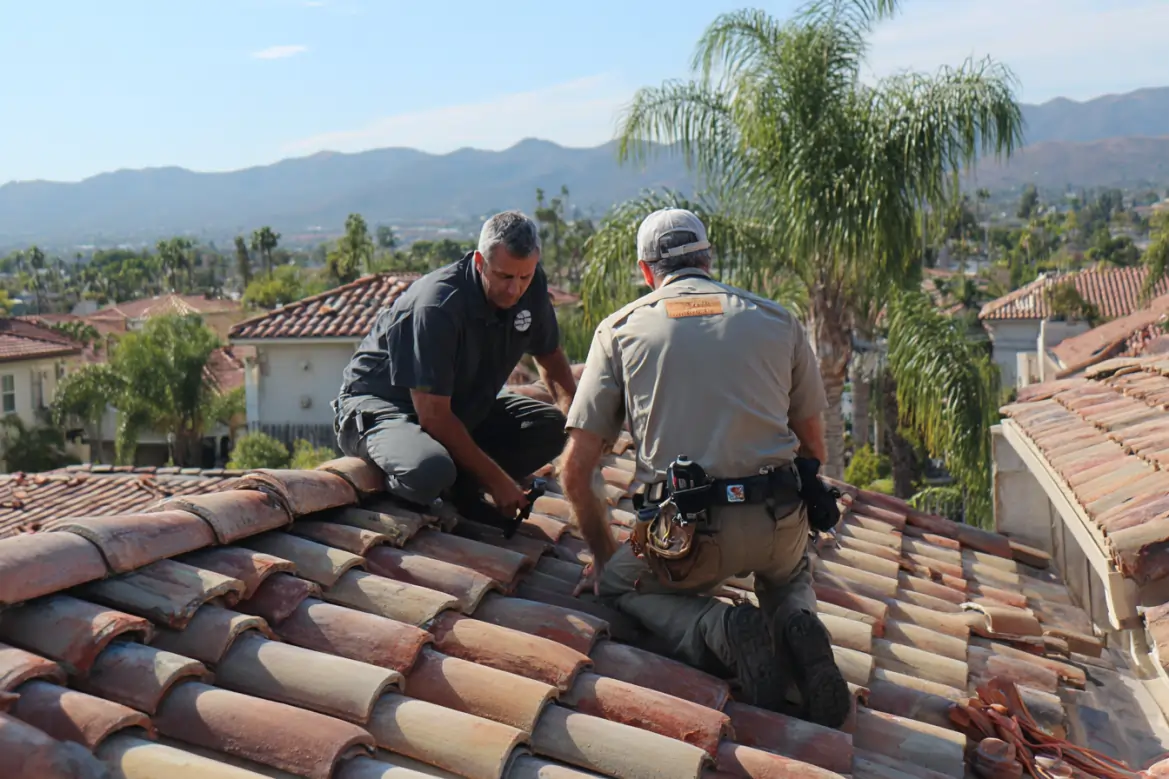
2. Clean Your Roof and Gutters
Think of your gutters as your roof’s drainage system—when it’s clogged, everything upstream is at risk. Over time, leaves, branches, dirt, and other debris accumulate, blocking water flow. A backed-up gutter doesn’t just cause overflow; it can send water under shingles, rot fascia boards, and even seep into your foundation, causing structural damage.
Cleaning Frequency: For most homes, twice a year is the baseline—once after autumn leaves have fallen and again in spring. If you have overhanging trees or live in a storm-prone area, monthly checks may be worth it.
Safe Gutter Cleaning Steps:
- Prepare: Use a sturdy ladder on stable ground and have someone nearby for safety.
- Protect: Wear gloves to guard against sharp edges and debris.
- Clear: Use a scoop or gutter-cleaning tool to remove debris into a bucket or tarp.
- Test Flow: Run water from a hose through gutters and downspouts to ensure proper drainage.
- Inspect: Look for sagging, leaks, or loose sections and repair immediately.
Roof Surface Care:
Debris like leaves, twigs, and seed pods can trap moisture, leading to mold, algae growth, and shingle decay. Use a soft-bristled broom or leaf blower on a low setting to gently clear your roof. Avoid harsh tools or power washers—they can strip protective granules and shorten shingle life.
Pro Tip: Apply a zinc or copper strip near the roof ridge to help prevent algae and moss growth naturally over time.
Consistent cleaning keeps water moving where it belongs—away from your home—while protecting both roofing materials and structural integrity. If climbing ladders or working on a roof feels unsafe, hire a professional. They can often pair cleaning with an inspection, saving you time and adding peace of mind.
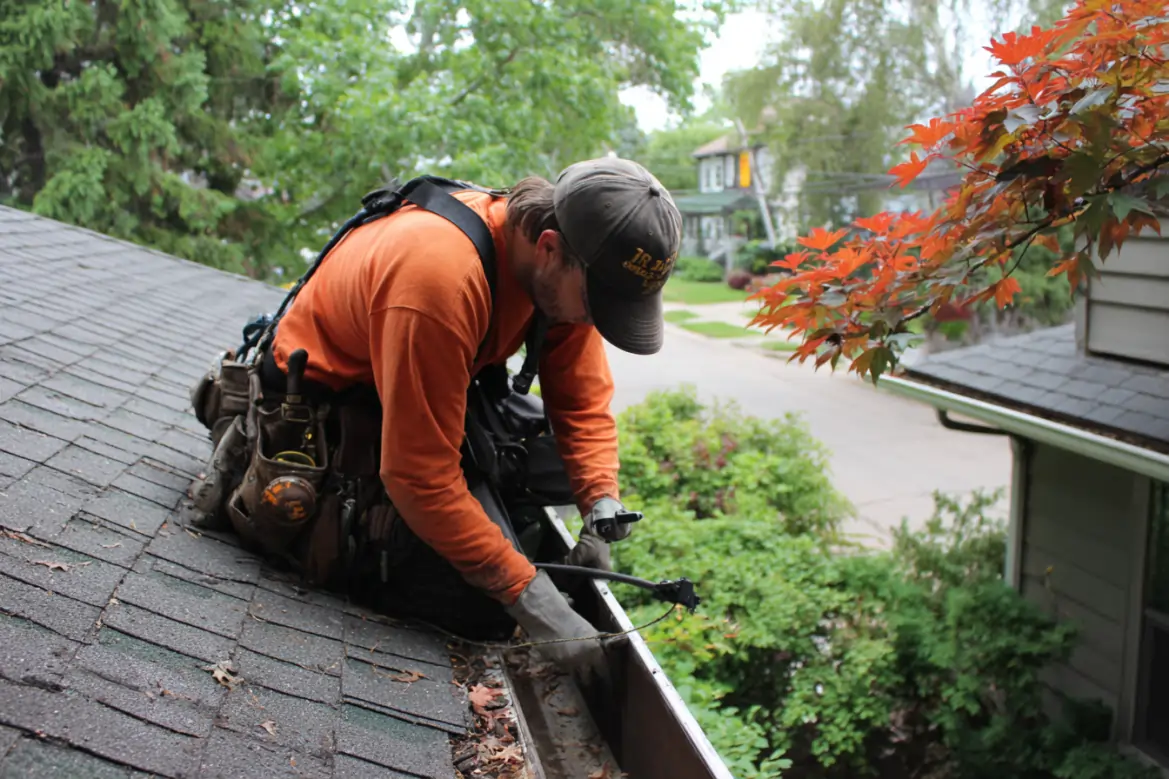
3. Address Moss, Mold, and Algae Promptly
What starts as a small green patch or faint dark streak can quietly become one of your roof’s worst enemies. Moss, mold, and algae thrive in damp, shaded areas, where they trap moisture against shingles. Over time, that trapped water can seep beneath roofing materials, weakening their structure and setting the stage for leaks, rot, and costly repairs.
Spotting the Signs Early:
- Moss: Thick, spongy, green clumps—often in shaded, north-facing areas.
- Algae: Dark streaks or stains, especially visible on light-colored shingles.
- Mold: Dark, blotchy spots, sometimes paired with a musty odor in attics or upper rooms.
Safe Removal Steps:
- Choose an eco-friendly, non-corrosive roof cleaner designed for shingles.
- Apply according to instructions, allowing time for the solution to loosen buildup.
- Gently brush with a soft-bristled broom—never scrape aggressively.
- Avoid power washing, which can strip protective granules and shorten shingle life.
Prevention Strategies:
- Metal Strips: Install copper or zinc strips along the ridge; rainwater carries ions that naturally inhibit growth.
- Tree Trimming: Reduce shade and increase airflow to keep surfaces dry.
- Regular Checks: Incorporate moss/algae inspection into your seasonal roof reviews.
Pro Tip: In areas with persistent moisture, consider algae-resistant shingles—they’re coated with copper granules for built-in protection.
If growth is widespread or stubborn, a roofing professional can treat it safely and inspect for underlying damage. Tackling these issues early keeps your roof looking clean, functioning efficiently, and lasting years longer—while preserving curb appeal and property value.
4. Check and Maintain Roof Flashing
Flashing is one of the unsung heroes of your roof—a thin layer of defense that stands guard where shingles meet vulnerable junctions like chimneys, skylights, vents, valleys, and edges. Its job is simple but critical: channeling water away from these points so it can’t sneak under your roofing and cause hidden damage.
What to Look for During Inspections:
- Cracks or Gaps: Open seams where water can enter.
- Rust or Corrosion: Especially on older metal flashing.
- Lifting or Separation: Flashing pulling away from the roof surface or masonry.
Even a small breach in flashing can be a direct path for water, leading to rot, mold, and long-term structural weakening.
Maintenance & Repair Tips:
- Minor Fixes: For small gaps or loosened sections, apply a compatible roofing sealant to restore a watertight seal.
- Replacement: If flashing is severely rusted or bent, replace it with corrosion-resistant materials like aluminum, galvanized steel, or copper for longer life.
- Periodic Resealing: Apply fresh sealant every few years, especially in high-rain or freeze-thaw climates, to prevent weather-induced failure.
Pro Tip: During any roof upgrade or major repair, upgrade to pre-formed flashing kits—they provide more consistent protection than custom-cut pieces made on-site.
If you’re unsure about handling flashing repairs, a professional roofing contractor can assess and repair problem areas quickly. Addressing flashing issues early is one of the fastest, most cost-effective ways to prevent leaks, protect your home’s structure, and extend the life of your entire roof system.
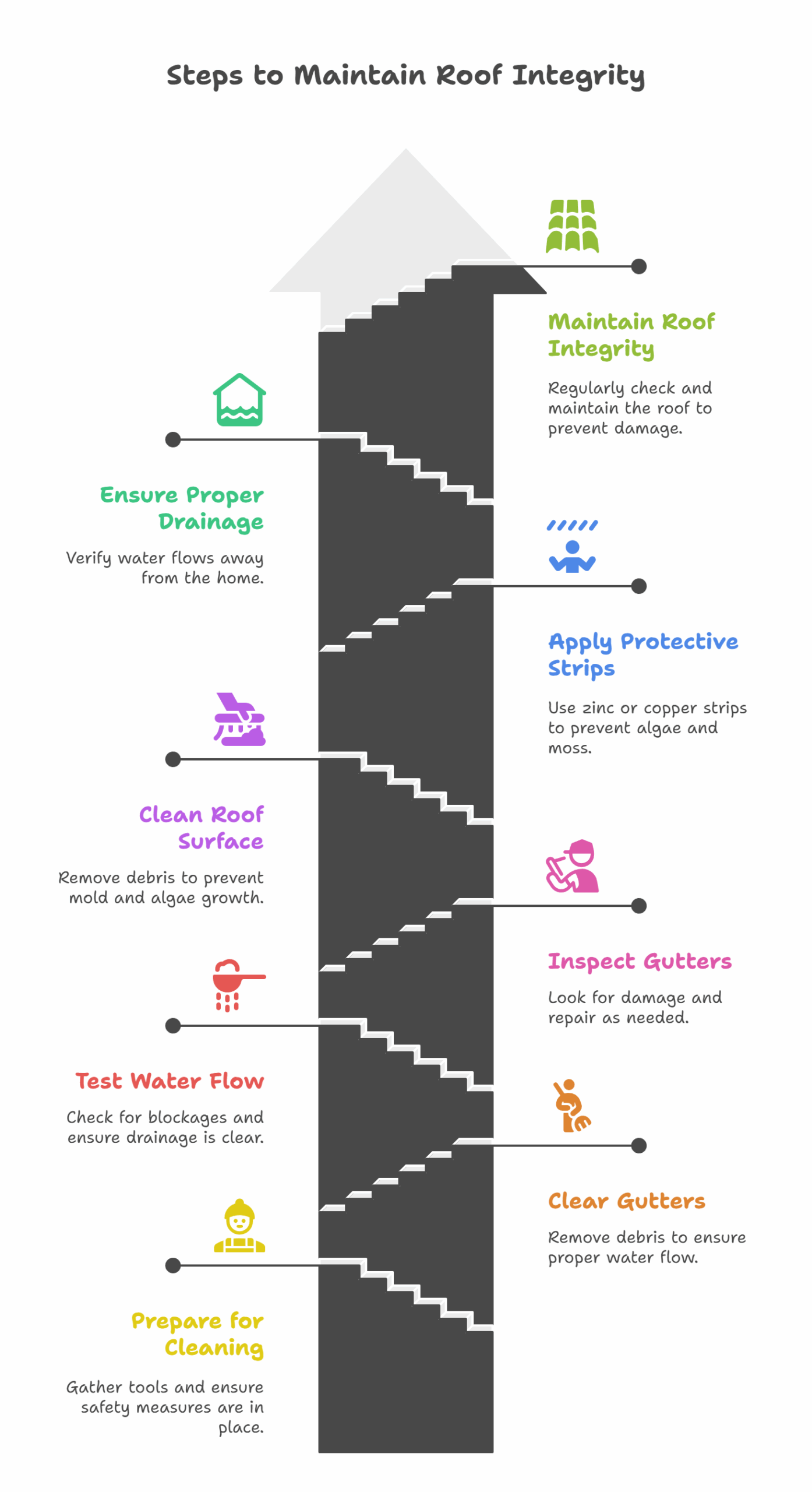
5. Tree Trimming and Roof Protection
Trees add character, shade, and value to your property—but without proper maintenance, they can also become one of your roof’s greatest hazards. Overhanging branches can scrape against shingles during windy conditions, wearing away protective granules and exposing the underlying material to sun and water damage. In severe storms, large branches can snap and fall, puncturing the roof or causing structural damage.
Tree debris—like leaves, pine needles, seed pods, and twigs—can also collect on the roof and in gutters. This buildup traps moisture, encourages moss and algae growth, and speeds up the deterioration of shingles.
Preventative Tree Maintenance Tips:
- Maintain Clearance: Keep branches trimmed back at least 6–10 feet from your roof to reduce impact risk and debris accumulation.
- Promote Drying: Increased sunlight exposure and better airflow help keep your roof dry and resistant to moss growth.
- Trim Properly: Make clean cuts just beyond the branch collar to protect the tree’s health.
When to Call a Professional:
- If branches are large, high, or close to power lines.
- If a tree shows signs of disease or instability that could lead to falling limbs.
Professional arborists can trim safely, preserve the tree’s long-term health, and protect your roof without risk to you or your property.
Pro Tip: Schedule trimming in late winter or early spring before new growth begins—this promotes healthy regrowth and keeps debris to a minimum during the warm months.
Consistent tree care not only extends your roof’s lifespan but also boosts curb appeal, improves ventilation around your home, and even reduces pest risks. A few hours of preventative work each year can save thousands in repair costs.
6. Ensuring Adequate Attic Ventilation
You can’t see it from the curb, but attic ventilation quietly determines how well your roof withstands the test of time. A properly ventilated attic regulates temperature, controls moisture, and prevents damage that can shorten the life of your roof—and even affect the comfort and efficiency of your entire home.
Why Ventilation Matters Year-Round:
- Summer: Without airflow, attic heat can soar above 150°F, accelerating shingle aging, warping roof decking, and forcing your AC to work harder.
- Winter: Warm, moist air from inside the home can condense on the underside of the roof deck, causing mold, rot, and ice dam formation. Ice dams allow water to back up under shingles, creating hidden leaks.
Warning Signs of Poor Ventilation:
- Attic feels extremely hot in summer.
- Mold, mildew, or musty odors.
- Frost buildup in winter.
- Unexplained spikes in heating or cooling bills.
Optimizing Airflow:
- Use a balanced system:
- Intake vents (soffit vents) draw in cool, fresh air.
- Exhaust vents (ridge vents, gable vents) release hot, moist air.
- For homes with unique roof designs or challenging climates, additional ventilation upgrades like solar-powered or electric attic fans can boost circulation.
- Always ensure vents are free from insulation blockages or debris.
Pro Tip: As a quick check, step into your attic on a warm day—if the temperature feels close to the outdoor air, your ventilation is likely working well.
Since every roof and climate is different, consulting a roofing professional ensures your ventilation setup is sized and positioned for maximum performance. Adequate attic ventilation protects your roof from hidden, costly damage, improves indoor comfort, and extends the lifespan of your entire roofing system.

7. Inspecting and Repairing Sealants and Caulking
Sealants and caulking may seem like small details, but they form one of your roof’s most important lines of defense against water intrusion. These flexible barriers protect vulnerable transition points—around vent pipes, skylights, chimneys, valleys, and roof edges—where different materials meet and water tends to find a way in.
Why Sealants Fail:
Sun exposure, wind, rain, and seasonal temperature swings cause sealants to dry out, shrink, crack, or peel. As soon as gaps appear, moisture can infiltrate, leading to hidden leaks, rotted decking, or interior water damage.
Inspection Checklist:
- Look for shrinkage or gaps along seams.
- Check for brittleness or material that crumbles when touched.
- Watch for discoloration—it can signal UV degradation.
- Examine closely where roofing meets flashing, siding, or masonry.
Quick Repairs for Minor Damage:
- Remove loose or deteriorated sealant with a plastic scraper.
- Clean the area thoroughly—dirt and old residue prevent adhesion.
- Apply a high-quality roofing sealant designed for exterior use.
- Silicone-based: Highly flexible, UV resistant.
- Polyurethane-based: Strong adhesion, durable in extreme weather.
- Smooth the bead for a watertight finish.
Pro Tip: Time your resealing for mild, dry weather—extreme heat or cold can affect curing and adhesion.
When to Call a Pro:
If large areas are failing, or if damaged sealant is paired with signs of roof deterioration (like rusted flashing or rotted wood), a professional assessment ensures the underlying issue is addressed—not just the surface symptoms.
Regularly maintaining sealants and caulking keeps water exactly where it belongs—off your roof and out of your home. A few minutes with a caulk gun now can prevent thousands in repairs later.
8. Protecting Your Roof from Sun and Heat Damage
San Diego’s abundant sunshine is one of its greatest perks—but your roof pays the price for year-round UV exposure and high temperatures. Over time, ultraviolet rays break down roofing materials, causing shingles to fade, crack, curl, or become brittle. Prolonged heat can dry out sealants, warp underlayment, and weaken the roof’s protective layers, shortening its lifespan.
Early Signs of Sun Damage:
- Color Fading: Especially on asphalt shingles—an early indicator of granule loss.
- Brittleness or Curling: Shingles lose flexibility and become more prone to cracking.
- Sealant Dry-Out: Around flashing, vents, and skylights, leading to gaps and leaks.
- Tile Damage: Loose, chipped, or broken pieces on clay or concrete tile roofs.
Protection Strategies:
- Cool Roofing Materials: Opt for light-colored shingles, clay tiles, or reflective coatings that deflect UV rays and reduce heat absorption.
- Reflective Coatings: Elastomeric or silicone-based coatings can restore weather resistance and prolong roof life.
- Specialized Membranes: For flat or low-slope roofs, UV-resistant membranes offer both protection and energy efficiency.
- Attic Ventilation: Balanced intake and exhaust vents help dissipate trapped heat, reducing thermal stress from below.
Pro Tip: Schedule inspections before and after the hottest months to catch early deterioration. For tile roofs, a professional check ensures broken or loose tiles are replaced before water intrusion occurs.
By combining reflective materials, proper ventilation, and regular inspections, you can significantly slow sun-related wear, lower cooling costs, and maintain both your roof’s strength and your home’s curb appeal in San Diego’s sunny climate.
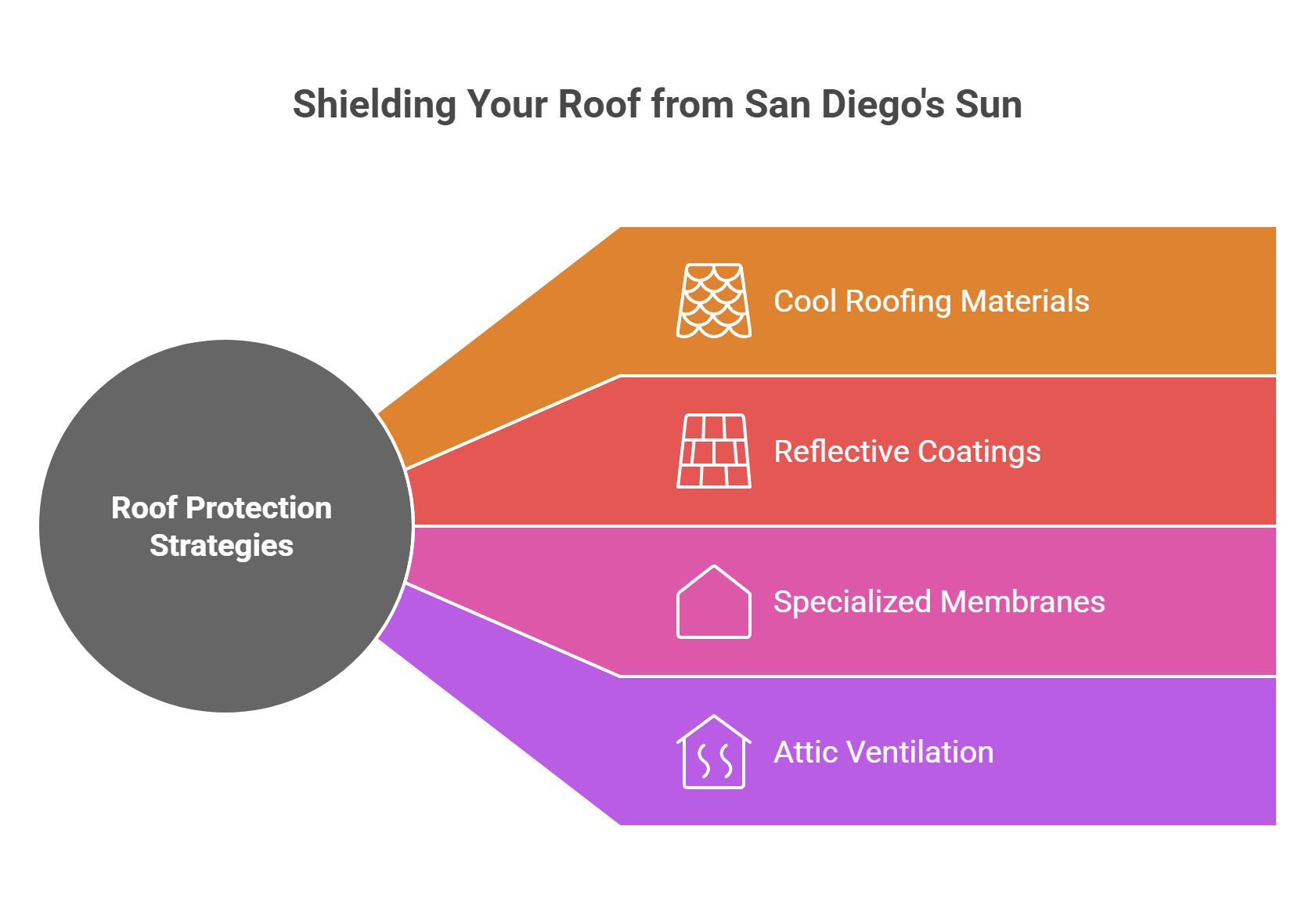
9. Knowing When to Call a Professional
Regular DIY maintenance is invaluable—but some roof problems require more than a ladder and a keen eye. Without the right tools, training, and safety precautions, tackling complex repairs can lead to greater damage—or even serious injury. Knowing when to bring in a professional is just as important as knowing how to maintain your roof yourself.
Clear Signs It’s Time to Call a Roofer:
- Persistent leaks or water stains that keep reappearing.
- Sagging or uneven sections of the roof deck.
- Extensive shingle or tile loss, cracking, or curling.
- Flashing that’s rusted, missing, or separating from the roof surface.
- Widespread moss, algae, or mold growth that returns quickly after cleaning.
Why Professional Expertise Matters:
- Hidden Issues: Roofers can spot problems invisible to the untrained eye, such as underlayment failure or compromised decking.
- Code Compliance: Repairs are completed to building code standards, protecting warranties and insurance coverage.
- Proper Materials: Professionals match repair materials to your existing roof for seamless protection and appearance.
- Preventive Plans: Many roofers offer maintenance programs that extend your roof’s lifespan and reduce repair costs.
Local Advantage for San Diego Homeowners:
Working with a contractor experienced in the region means they’ll understand how intense UV exposure, heat stress, and occasional heavy rains impact materials—and can recommend upgrades like cool roofing or enhanced flashing that perform better in local conditions.
Pro Tip: If a contractor suggests full roof replacement, ask for a detailed inspection report with photos—this transparency helps you make an informed, cost-effective decision.
By calling in a pro when the warning signs appear, you protect your roof from escalating damage, keep your home safe and comfortable, and preserve property value for years to come.
10. Creating a Roof Maintenance Schedule
A roof that lasts decades doesn’t happen by accident—it’s the result of consistent, well-timed care. A structured maintenance schedule keeps you proactive, allowing you to spot and address small issues before they become costly repairs.
Step 1: Set Your Inspection Calendar
- Biannual Inspections: Schedule one in spring (post-winter weather check) and one in fall (pre-storm season prep).
- San Diego Tip: Add a late-summer inspection to assess UV and heat damage after peak sun exposure.
- Post-Storm Checks: Inspect after severe winds or heavy rain.
Step 2: Schedule Seasonal Maintenance
- Spring/Fall: Clear gutters, remove debris from the roof, and trim back overhanging branches.
- Winter Prep (where applicable): Check flashing, sealants, and attic insulation before cooler months.
- Summer Prep: Inspect for fading, curling, or brittle shingles, especially on sun-facing slopes.
Step 3: Plan Professional Services
- Annual Professional Inspection: Even if your roof appears fine, a roofer can detect hidden issues.
- Specialized Tasks: Hire pros for resealing flashing, replacing damaged shingles or tiles, and applying reflective coatings.
Step 4: Keep a Roof Logbook
Record each inspection date, findings, repairs, and services performed. Include before-and-after photos where possible. This log helps track roof health, guides future maintenance, and serves as proof of care if you sell your home.
Pro Tip: Set digital reminders on your phone or calendar so inspections and cleanings become part of your yearly routine—just like servicing your HVAC system or changing smoke detector batteries.
By following a consistent schedule, you’ll extend your roof’s lifespan, save money on repairs, and have confidence that your home is well-protected in every season.
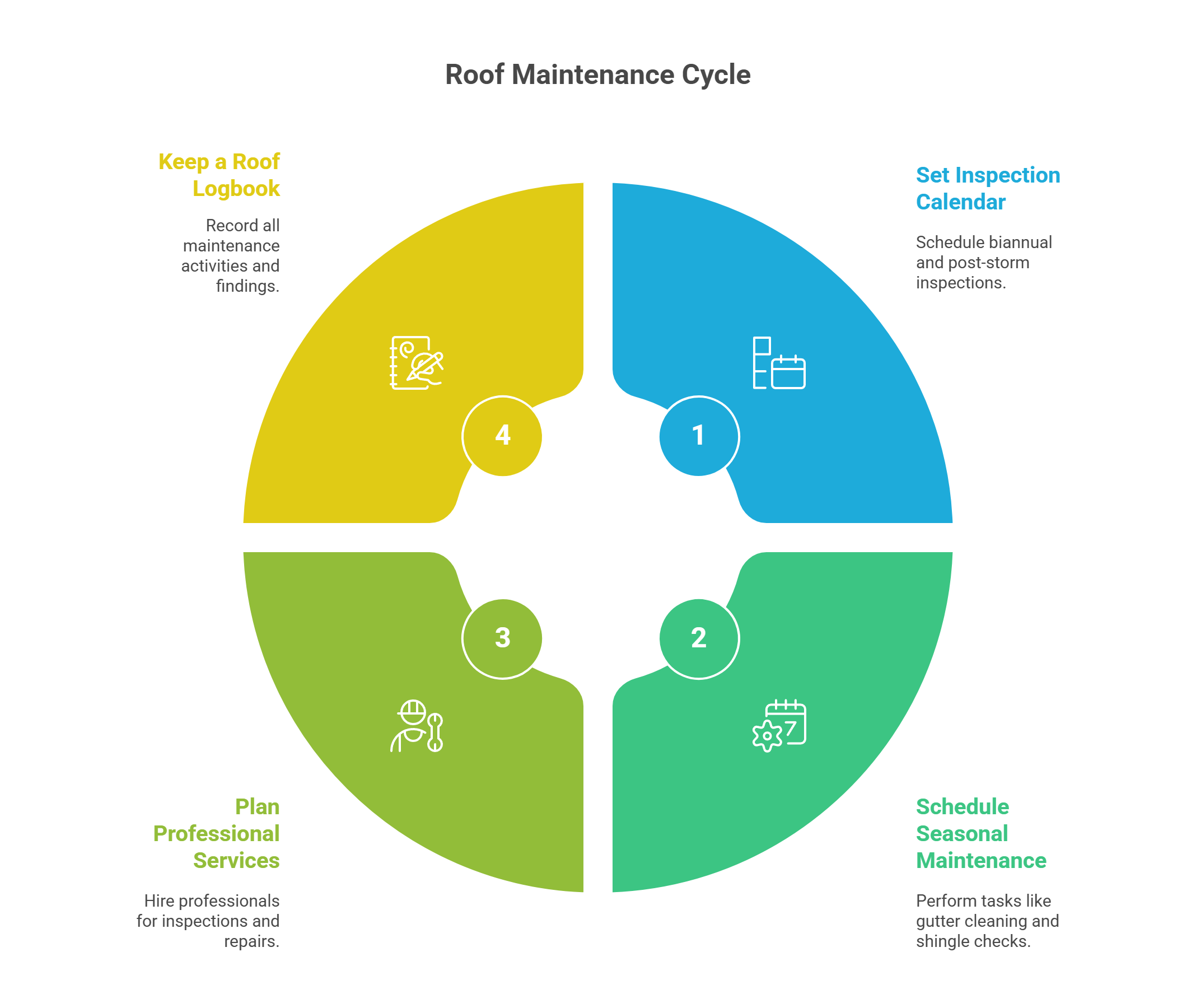
Recent Posts
Attic Insulation Upgrades That Cut Cooling Costs
San Diego Roof Lifespans Explained
Do you have any questions?
Contact us at the Gen819 office nearest to you or submit a business inquiry online
Contact Us









